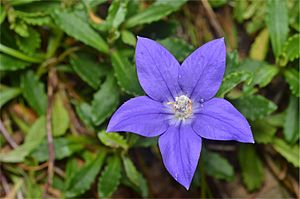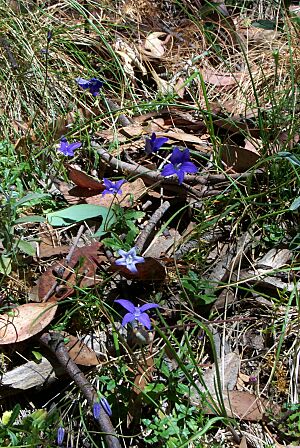Royal bluebell facts for kids
Quick facts for kids Royal bluebell |
|
|---|---|
 |
|
| Wahlenbergia gloriosa in a Canberra suburban garden | |
| Scientific classification | |
| Genus: |
Wahlenbergia
|
| Species: |
gloriosa
|
The Royal Bluebell, also known by its scientific name Wahlenbergia gloriosa, is a beautiful plant that grows year after year. It's a type of herb in the bluebell family. This plant has special leaves: some are shaped like eggs near the bottom of its stem, and others are long and thin higher up. It usually has one stunning purple flower with a tube-like base. This flower is so special that it's the official flower symbol of the Australian Capital Territory!
Contents
What the Royal Bluebell Looks Like

The Royal Bluebell is a plant that lives for many years. It has roots that spread underground, and its stems grow straight up. These stems are usually between 6 and 40 millimeters (about 0.2 to 1.6 inches) tall.
Leaves of the Plant
The leaves of the Royal Bluebell are often close together. They can be different shapes and sizes. Near the bottom of the stem, the leaves are often egg-shaped or narrow and oval. Higher up, they become long and thin, or shaped like a spear. They can be from 4 to 35 millimeters (about 0.16 to 1.4 inches) long and 1 to 15 millimeters (about 0.04 to 0.6 inches) wide. The edges of the leaves often look wavy and sometimes have tiny teeth.
Royal Bluebell Flowers
Usually, just one flower grows on a long, smooth stalk that can be 4 to 25 centimeters (about 1.6 to 9.8 inches) long. Sometimes, two or three flowers can appear. Small, smooth, linear or spear-shaped leaves called bracteoles are found on the flower stalk.
The flower usually has five smooth, narrow, triangular parts called sepals, which are about 2.5 to 7 millimeters (about 0.1 to 0.3 inches) long. The petals are purple and are joined at their bases to form a tube that looks like a bell. This tube is about 2.5 to 8.5 millimeters (about 0.1 to 0.3 inches) long. At the end of the tube, there are four, five, or six lobes (sections) that are 11 to 25 millimeters (about 0.4 to 1 inch) long and 6 to 12 millimeters (about 0.2 to 0.5 inches) wide.
Inside the flower, there are usually five white stamens, which are about 2 to 3 millimeters (about 0.08 to 0.12 inches) long. There's also a white style with two branches at its end.
Fruit and Life Cycle
The Royal Bluebell flowers in spring. After flowering, it produces a smooth, cone-shaped fruit called a capsule. This capsule is about 8 to 12 millimeters (about 0.3 to 0.5 inches) long and 3 to 5 millimeters (about 0.12 to 0.2 inches) wide.
How the Royal Bluebell Got Its Name
The Royal Bluebell, Wahlenbergia gloriosa, was first officially described in 1947. This description was made by a person named Noel Lothian. He published his findings in a scientific paper. The plant was found on Mount Buffalo by Percival St John.
The second part of its scientific name, gloriosa, comes from a Latin word. This Latin word means "famous" or "splendid," which perfectly describes this beautiful flower!
Where the Royal Bluebell Grows
The Royal Bluebell is quite common in certain areas. It likes to grow in forests and woodlands that are found in subalpine zones. These are areas just below the main alpine (mountain) regions. You often find it in rocky places. It also grows in high mountain grasslands and areas with many herbs, usually above 1500 meters (about 4900 feet) in elevation.
You can find the Royal Bluebell in the Australian Capital Territory, in the southeastern part of New South Wales, and in the high country of Victoria. These areas are all part of the Australian Alps.
Growing Royal Bluebells at Home
The Royal Bluebell is a great plant for gardens because it can handle frost. It grows best in places that get a lot of sun or a little bit of shade, especially in cooler parts of Australia.
How to Plant Them
You can start new Royal Bluebell plants in a few ways:
- By dividing an existing plant (carefully splitting it).
- From cuttings (taking a piece of the stem and growing roots from it).
- From seeds.
The plant likes soil that has lots of well-rotted organic material, like compost. It's important to keep the soil moist, but make sure it doesn't get too wet or waterlogged.

